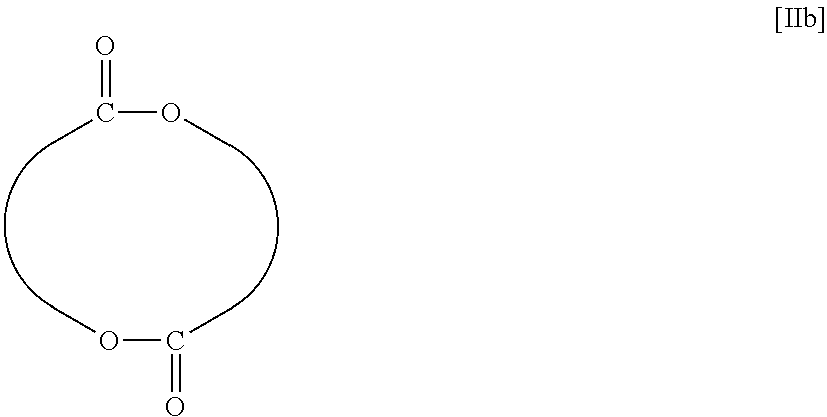Method for producing polyester
a technology of polyester and cellulose, applied in the field of polyester production, can solve the problems of difficult decomposition of lactides and difficult elimination of water from the surface of the water, and achieve the effect of inhibiting the ring-opening polymerization reaction
- Summary
- Abstract
- Description
- Claims
- Application Information
AI Technical Summary
Benefits of technology
Problems solved by technology
Method used
Image
Examples
example 1
[0066]In a 200 mL recovery flask, 5.81 g (40.3 mmol) of dilactide and 27.83 g of toluene were put, and the resultant mixture was warmed to 50° C. To the mixture, 0.55 g of a solution of 1.0 M triethylaluminum in hexane (made by Sigma-Aldrich Co. LLC, specific gravity: 0.692) was added at 50° C., and the resultant mixture was stirred at 50° C. for 80 minutes. The solution was analyzed. A polymer detectable by GPC was not formed therein.
[0067]To the solution, 0.20 g of a solution of 1.0 M dibutylmagnesium in heptane (made by Sigma-Aldrich Co. LLC, specific gravity: 0.713) was added at 50° C., and the resultant mixture was stirred at 50° C. for 5 hours. Then, the mixture was allowed to cool to room temperature. The resultant solution was analyzed. Polyester having a weight average molecular weight (Mw) of 24,400 and a molecular weight distribution (Mw / Mn) of 1.74 was detected therein.
example 2
[0068]In a 200 mL recovery flask, 5.95 g (41.3 mmol) of dilactide and 38.9 g of cyclopentyl methyl ether were put, and the resultant mixture was warmed to 60° C. To the mixture, 0.34 g of a solution of 1.0 M triethylaluminum in hexane (made by Sigma-Aldrich Co. LLC, specific gravity: 0.692) was added at 60° C., and the resultant mixture was stirred at 60° C. for 30 minutes. The solution was analyzed. A polymer detectable by GPC was not formed therein.
[0069]To the solution, 0.27 g of a solution of 1.0 M diethylzinc in hexane (made by Sigma-Aldrich Co. LLC, specific gravity: 0.726) was added at 60° C., and the resultant mixture was stirred at 60° C. for 30 hours. Then, the mixture was allowed to cool to room temperature. The resultant solution was analyzed. Polyester having a weight average molecular weight (Mw) of 27,100 and a molecular weight distribution (Mw / Mn) of 2.50 was detected therein.
example 3
[0070]In a 200 mL recovery flask, 5.82 g (40.4 mmol) of dilactide, 25.46 g of toluene and 15.12 g of tetrahydrofuran were put, and the resultant mixture was warmed to 60° C. In the solution, 0.55 g of a solution of 1.0 M triethylaluminum in hexane (made by Sigma-Aldrich Co. LLC, specific gravity: 0.692) was added at 60° C., and the resultant mixture was stirred at 60° C. for 30 minutes. The solution was analyzed. A polymer detectable by GPC was not formed therein.
[0071]To the mixture, 0.56 g of a solution of 0.517 parts by mass of 1,5,7-triazabicyclo[4.4.0]-5-dodecene in 9.61 parts by mass of tetrahydrofuran were added at 60° C., and the resultant mixture was stirred at 60° C. for 8 hours. Then, the mixture was allowed to cool to room temperature. The resultant solution was analyzed. Polyester having a weight average molecular weight (Mw) of 13,800 and a molecular weight distribution (Mw / Mn) of 1.54 was detected therein.
PUM
| Property | Measurement | Unit |
|---|---|---|
| temperature | aaaaa | aaaaa |
| temperature | aaaaa | aaaaa |
| time | aaaaa | aaaaa |
Abstract
Description
Claims
Application Information
 Login to View More
Login to View More - Generate Ideas
- Intellectual Property
- Life Sciences
- Materials
- Tech Scout
- Unparalleled Data Quality
- Higher Quality Content
- 60% Fewer Hallucinations
Browse by: Latest US Patents, China's latest patents, Technical Efficacy Thesaurus, Application Domain, Technology Topic, Popular Technical Reports.
© 2025 PatSnap. All rights reserved.Legal|Privacy policy|Modern Slavery Act Transparency Statement|Sitemap|About US| Contact US: help@patsnap.com



